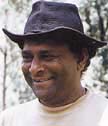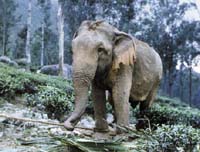 |
 1st March 1998 |
Front Page| |
Jumbo task amidst the teaAfter a plan to airlift trapped elephants in Poonagalla was grounded last year, a new translocation operation has been launched much to the relief of terrified estate labourers. But given the mountainous terrain Wildlife Dept. officials are facing a daunting task. Renuka Sadanandan and Tharuka Dissanaike report
Twenty seven years ago, in June 1971, the wife of a planter at Poonagalla wrote in the Wildlife Society's journal The Loris about a "Tusker in the tea" (see box story). For many, the thought of elephants in tea country as mountainous as this is hard to believe, but for some years now the problem of elephants trapped in pockets of forest in the Uva hill country has assumed dangerous dimensions. At the Poonagalla and Macaldeniya estates, some eight people have been killed and crops destroyed with increasing regularity. Something had to be done. Last week, a team of Wildlife Department officials headed by Deputy Director Dr. Nandana Atapattu set out with the aim of capturing and translocating some of the animals to give some relief to the beleaguered estate workers. "The estate labourers are desperate," Dr. Atapattu told The Sunday Times. "If we don't act, they will do something to the animals, kill them or poison them. So the only alternative is for us to tranquilise and move them to a safer area." People in the area estimated that there were around 10 to 12 elephants who descended the steep slopes at night in search of food. Dr Atapattu had identified five, all bull elephants. "It is not a herd but we find that these males sometimes exhibit homosexual tendencies and stay together," he said.
"Under normal circumstances we would not tranquilise an animal so late in the evening, but here we had to take the chance," said Dr Atapattu. The elephant, which Dr Atapattu estimated to be around 45 years and in reasonably good health with no injuries except hundreds of healed pellet wounds was tranquilised and quickly tethered to nearby trees. The next stage of the operation was however the difficult one where the elephant, now amidst the tea bushes had to be led down to where the Wildlife Department truck had inched its way through the narrow and winding estate roads to the highest motorable point. Dr. Atapattu had to request for a domestic elephant who would lead the captured jumbo to the waiting truck. It was a painstaking process and took Department staff three days to move the elephant barely over a kilometer- all because of the difficult sloping terrain. It was not the first time a solution had been sought. In February last year, in their first foray at Poonagalla, the Wildlife team aided by a battalion of estate workers, some 200 in number, had succeeded in driving some of the elephants down towards the Wellawaya Road but opposition from villagers in those areas scuttled their attempts to get the jumbos to safety. It was then that Dr Atapattu devised what turned out to be a controversial plan to airlift the elephants to safety. He envisaged tranquilising the elephants and since the lorries needed to transport them would not have access to the precipitous slopes, planned to have helicopters bring down containers on to which the animals could be loaded and safely lifted to the road where they could then be loaded on to the trucks which would take them to the wildlife sanctuaries. The "airlift" however, remained grounded. And when the Wildlife Department team tried again to move the elephants last week it turned out to be an operation fraught with difficulty, on terrain where every foot seemed a mile. "It is this difficulty and because of the danger in tranquilising an elephant on a steep hillside where it could then be injured seriously or even killed when it fell after the tranquiliser took effect that we requested for helicopters,"Dr. Atapattu said. "With the helicopters we could have reached the elephants without delay and got them out in minimum time, instead of going through this arduous process." In this case, the animal had to be frequently sedated, and fed while captive for three days, under a great deal of stress. "This is a trial. We will capture one elephant, transport it to safety and evaluate the procedure. To capture each elephant in this manner will be a long drawn out tedious affair. There could also be casualties due to the complications that arise in these areas as opposed to flat dry zone terrain. Normally we would have a bulldozer, and truck on hand, but the terrain here makes it impossible," Dr. Atapattu said. On Poonagalla and Macaldeniya there was relief that finally something was being done about their problem with elephants. They were not only responsible for many deaths but would destroy precious coconut, jak, plantain and del trees. "I had over a hundred coconut trees around my bungalow. Now there are barely three or four left," Rajah Sithambaram, Manager of Macaldeniya Estate said. He recalled, not so long ago he used to give coconut to his estate workers at very low prices. "Very soon I'll have to buy my own coconuts." His few remaining trees have coils of barbed wire wound around them to deter the hungry jumbos in search of the tender palm fronds. Nishantha Premarathne is Assistant Superintendent of Poonagalla Lower Division. A wildlife enthusiast, he would watch out for and video the elephants who came regularly to frolic on his lawn in the evenings and even look in through the windows. But large del trees in the estates are turning yellow on their way to perishing, the bark stripped by jumbos in his back garden. "At least they don't harm the tea," another planter said, in lighter vein. But the ever obvious presence of the elephants was no laughing matter. Exhausting food stocks on the lower ranges, they steadily move upwards through tea and estate forests. For the frightened estate workers the captured elephant represented a victory. By Friday evening the roped elephant had become quite an attraction- large crowds took buses and vans to Poonagalla Lower Division and a trail of sightseers trekked through the tea, just to take a closer look at the elephant as he restlessly strained on the thick ropes that bound him. Among the crowd was a gnarled estate worker Pichai, 67, a mother of thirteen who had walked several miles just to see the elephant. "At night we are very frightened in the line rooms. If an elephant is close, we all shout to chase it away. They hide in the shadows," she said. One such elephant, chased off from a line room killed 13 year old Sarabi's father last year. While walking back from Sithambaram's bungalow at Macaldeniya, Velu, 46, was crushed to death under the feet of an angry elephant, on the road. "Appa never came home that night. In the morning we found his body," Sarabi, a student of the Koslanda Government school said. As strange as it may sound, Dr. Atapattu claims that this mountainous terrain was the elephants traditional homeland. "Elephants used to live all over the mountain country, in Bandarawela, Nuwara Eliya and Horton Plains. Tea and coffee plantations drove the herds to the dry zone jungles." And now they are back. The few elephants terrorising Poonagalla and Macaldeniya have been trapped away from the dry zone Wellawaya area by development and chena cultivation. But it is obvious that they cannot make tea estates their permanent habitat." "If we don't translocate these elephants sometime this year, they will soon find their way up this estate to Bandarawela town," Dr Atapattu said. How, is the big question? It took the Wildlife Department team of 15 men almost five days to tackle one elephant. The risk was great, as Dr Atapattu pointed out. They had just Rs 20,000 for the entire operation and it would not have been possible if not for the help of the estate personnel. Is the airlift the answer? And should funds be sought from foreign agencies, who says Dr Atapattu would be willing to assist. What is obvious is that the elephants, if they are to be saved, must be found a new home.
|
||
|
More Plus * The ocean calls our name
|
||
|
Please send your comments and suggestions on this web site to The Sunday Times or to Information Laboratories (Pvt.) Ltd. |
||
 Dusk
spells an unoffi- cial curfew for the workers on the mist shrouded hillsides
of Poonagalla Estate. They dare not venture out of their line rooms after
nightfall. They have found, through bitter experience that their lives
are at risk from marauding elephants.
Dusk
spells an unoffi- cial curfew for the workers on the mist shrouded hillsides
of Poonagalla Estate. They dare not venture out of their line rooms after
nightfall. They have found, through bitter experience that their lives
are at risk from marauding elephants. It
was Wednesday evening, close upon five when the trackers came upon a lone
elephant lower down on the slopes. A convenient rock nearby and the relatively
flatter terrain made it too good an opportunity to miss.
It
was Wednesday evening, close upon five when the trackers came upon a lone
elephant lower down on the slopes. A convenient rock nearby and the relatively
flatter terrain made it too good an opportunity to miss. 
